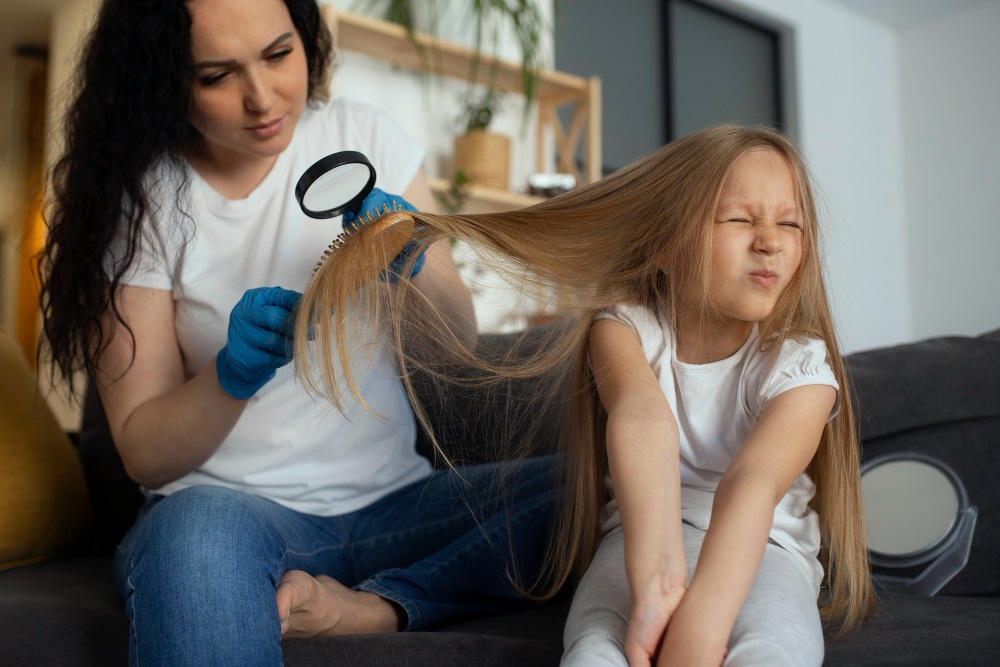Dealing with head lice can be a challenging and often frustrating experience. However, with the right approach, it’s possible to get rid of head lice effectively, ensuring comfort and peace of mind. Head lice infestations can disrupt daily life, causing discomfort and stress, especially in a household with children. They’re a source of concern for parents, online child health consultation can provide easy access to medical advice which can help with head lice more efficiently. This blog post will discuss several proven strategies to help you manage this common issue. We will explore not just the treatment, but also ways to understand, prevent, and control head lice infestations effectively.
Recognizing the Symptoms Promptly
Recognizing the signs of head lice early plays a critical role in the timely and effective management of the condition. Awareness of the primary indicators is essential for prompt action.
Itching:
This symptom is often the first sign of a lice infestation. It’s caused by an allergic reaction to the saliva of lice. The itching can vary from mild to severe and is typically worse around the neck, ears, and scalp. If the itching is severe, an online doctor consultation can provide suitable treatments advice after diagnosis.
A feeling of Movement:
Some individuals report a tickling or crawling sensation on their scalp. This feeling is caused by the movement of lice through the hair. It can be particularly noticeable in quiet moments, such as when lying in bed.
Lice on Scalp:
Spotting live lice can be challenging due to their small size and quick movements. They are typically found close to the scalp, often around the nape of the neck and behind the ears, where they find warmth and food.
Nits on Hair Shafts:
Nits are lice eggs and appear as tiny, oval specks. They are firmly attached to the hair shafts and unlike dandruff, they cannot be easily brushed off. They are a telltale sign of an ongoing infestation.
Underlying Causes
Exploring the causes of head lice includes considering a range of factors that contribute to their prevalence and transmission in various environments and communities. For detailed understanding and advice, an online GP registration on Consultdoc can offer comprehensive medical guidance from diagnosis to the treatment process.
Direct Head-to-Head Contact:
Lice crawl from one head to another, which is why children playing closely together are often affected. This mode of transmission is common in schools, sports activities, and during play dates.
Sharing Personal Items:
Lice can spread through the sharing of combs, brushes, hats, and other hair accessories. Although less common, it’s a potential route for lice transfer, especially among family members or close friends.
Contact with Contaminated Furniture:
Lice or nits can fall off a person’s hair and temporarily survive on upholstered furniture, bedding, towels, or clothing. Using these items can lead to a new person picking up the lice.
Treatment Intervention
The key to successfully treating head lice lies in a multifaceted approach that combines targeted treatments with diligent personal care practices to effectively manage and eradicate infestation.
Use Anti-Lice Treatments
There are various over-the-counter (OTC) treatments and prescription medications available to get rid of head lice. These products usually contain ingredients like permethrin or pyrethrin, which are effective at killing lice.
Wet Combing
This method involves using a fine-toothed lice comb on wet, conditioned hair to physically remove lice and nits. It’s a safe and natural way to get rid of head lice, especially for those who prefer to avoid chemical treatments. This process should be repeated several times over a week to ensure all lice and nits are removed.
Essential Oils
Some people find relief from head lice through the use of essential oils like tea tree oil, lavender oil, and neem oil. While there is limited scientific evidence supporting their efficacy, many report success. If you opt for this method, ensure to dilute the oils properly and perform a patch test to avoid skin irritation.
Maintain Hair Hygiene
While lice aren’t a result of poor hygiene, maintaining clean hair can help prevent re-infestation. Wash hair regularly and keep it tied up if long. This tip is especially important in households with children, where lice can spread more easily.
Environmental Cleaning
To effectively get rid of head lice, it’s crucial to clean the environment. Wash bedding, and clothing, in hot water. Vacuum carpets and furniture to remove any fallen hairs that might have nits attached.
Prevention Strategies
Effective prevention of head lice hinges on adopting a proactive and consistent approach, integrating strategies that address various aspects of personal care and environmental awareness.
Regular Hair Checks:
Frequent and thorough checks, especially after notification of lice in the community, can help in early detection and treatment. This can be done at home or by professionals.
Maintain Personal Hygiene:
Regular washing and maintaining the cleanliness of hair can help deter lice infestation, though lice can affect clean hair too. It’s more about avoiding conditions that facilitate their spread.
Clean Personal Belongings:
Regular cleaning and laundering of personal items like hats, scarves, and headphones can prevent the spread of lice. High heat drying of these items can kill lice and nits.
Conclusion
To effectively get rid of head lice, it requires a comprehensive approach that includes being aware of symptoms, understanding transmission methods, and implementing preventive measures. By staying informed, proactive, and cooperating with community efforts, we can significantly reduce the impact and spread of head lice. Collaboration and education are key to managing this common issue effectively. In this journey, patience and consistency are vital. Sharing experiences and tips can benefit others in similar situations, fostering a supportive environment.
